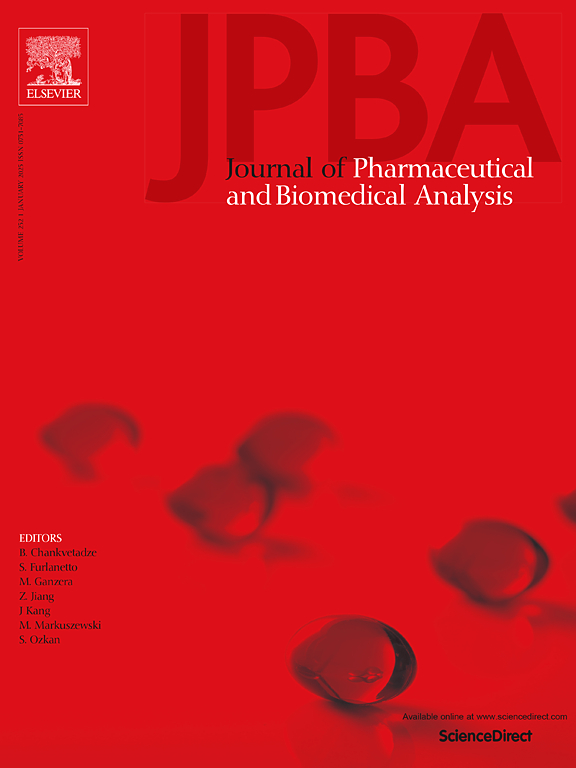A sensitive reverse-phase ultra performance liquid chromatography-tandem mass spectrometry method for the determination of tobramycin in Pseudomonas aeruginosa cell lysate
IF 3.1
3区 医学
Q2 CHEMISTRY, ANALYTICAL
Journal of pharmaceutical and biomedical analysis
Pub Date : 2025-02-26
DOI:10.1016/j.jpba.2025.116743
引用次数: 0
Abstract
Measurement of antibiotic accumulation in bacteria is essential for full understanding of the mechanisms of antimicrobial resistance but requires a highly sensitive analytical assay. A suitable ultra performance reverse phase liquid chromatographic tandem mass spectrometry (UPLC-MS/MS) method was developed in the electrospray negative ionisation mode for quantifying tobramycin in Pseudomonas aeruginosa cell extracts. P. aeruginosa cell lysate extracts were prepared and spiked with tobramycin and kanamycin (internal standard). Following a protein precipitation extraction procedure, the sample was applied to a reverse phase C18 column, equilibrated in 10 mM ammonium hydroxide at pH 11. Tobramycin and kanamycin were eluted using an acetonitrile gradient and detected in the electrospray negative ionisation mode. The retention times for kanamycin and tobramycin were 1.9 and 2.5 min, respectively and total run time of 10 min. The assay demonstrated linearity in the range of 0.02 – 1 µg mL−1 (R = 0.9999), with limits of detection and quantitation at 1.42 ng mL−1 and 10 ng mL−1, respectively. The precision, expressed as the coefficient of variation, ranged from 1.4 % to 6.5 %, and the accuracy, expressed as bias, ranged from 0.4 % to 17.1 % (ICH, 1996). Using a simple protein precipitation method, the recoveries (%) of tobramycin from cell lysate supernatant for quality controls were 99.7–105.2 % and this result shows that the assay is quantitative. This validated analytical protocol will facilitate future studies aimed at determining the cellular uptake kinetics of tobramycin by P. aeruginosa under various controlled conditions and it could be used for other applications.
求助全文
约1分钟内获得全文
求助全文
来源期刊
CiteScore
6.70
自引率
5.90%
发文量
588
审稿时长
37 days
期刊介绍:
This journal is an international medium directed towards the needs of academic, clinical, government and industrial analysis by publishing original research reports and critical reviews on pharmaceutical and biomedical analysis. It covers the interdisciplinary aspects of analysis in the pharmaceutical, biomedical and clinical sciences, including developments in analytical methodology, instrumentation, computation and interpretation. Submissions on novel applications focusing on drug purity and stability studies, pharmacokinetics, therapeutic monitoring, metabolic profiling; drug-related aspects of analytical biochemistry and forensic toxicology; quality assurance in the pharmaceutical industry are also welcome.
Studies from areas of well established and poorly selective methods, such as UV-VIS spectrophotometry (including derivative and multi-wavelength measurements), basic electroanalytical (potentiometric, polarographic and voltammetric) methods, fluorimetry, flow-injection analysis, etc. are accepted for publication in exceptional cases only, if a unique and substantial advantage over presently known systems is demonstrated. The same applies to the assay of simple drug formulations by any kind of methods and the determination of drugs in biological samples based merely on spiked samples. Drug purity/stability studies should contain information on the structure elucidation of the impurities/degradants.

 求助内容:
求助内容: 应助结果提醒方式:
应助结果提醒方式:


